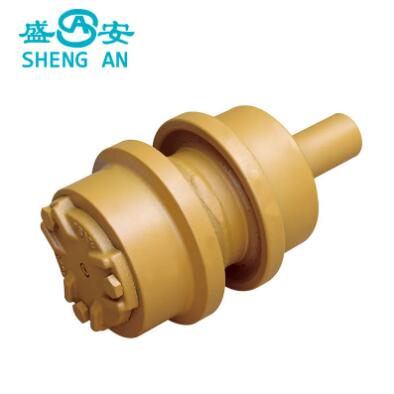Choosing the Right Excavator Carrier Rollers for Maximum Efficiency
2024-09-10
When it comes to excavator performance, the undercarriage plays a vital role in ensuring both stability and smooth operation. At the heart of this system is the carrier roller, a component that helps guide the tracks and maintain proper alignment. Without the right carrier roller, an excavator can experience issues with wear, misalignment, and decreased operational efficiency.
In this blog, we’ll look at the factors to consider when selecting the right carrier roller for your excavator, the signs that your carrier roller may need replacement, and how to maintain it to ensure long-term performance.
What Makes Carrier Rollers Essential?
Carrier rollers, though small compared to other parts of the excavator, are essential for ensuring the alignment and tension of the excavator tracks. A well-chosen carrier roller helps the excavator:
- Operate Smoothly: By reducing track sagging, the roller ensures the machine can move without jerky or uneven motions, improving overall operational efficiency.
- Extend Track Life: By distributing the load across the track system evenly, the carrier roller helps minimize wear and tear on the tracks, increasing their longevity.
- Enhance Stability: The roller ensures better weight distribution, reducing the chances of track derailment, especially when the excavator is working on uneven terrain or slopes.
How to Choose the Right Carrier Roller
Selecting the right carrier roller for your excavator requires considering several factors:
1. Excavator Model and Size: Carrier rollers are designed to match specific excavator models. Make sure to check the machine’s manual or consult with a supplier to find rollers that are compatible with your model. Larger excavators require more robust and durable rollers, often with double flanges, to support their weight.
2. Operating Conditions: Consider the environment in which your excavator will be operating. Machines working on soft or muddy terrain will require different roller specifications than those operating on hard surfaces or rocky areas. For rough terrains, opt for hardened steel rollers that are resistant to impact and wear.
3. Flange Type: Carrier rollers come in both single and double flange designs.
- Single Flange Rollers: Typically used for smaller machines or operations on flatter terrain, these rollers offer decent support but may not be suitable for challenging conditions.
- Double Flange Rollers: Better suited for large excavators or when working on uneven or rough terrains, double flange rollers provide extra stability and reduce the risk of derailment.
4. Seals and Bearings: Ensure that the carrier roller has high-quality seals and bearings to prevent dirt, water, or debris from entering and causing damage. Good seals ensure the smooth operation of the roller, reducing maintenance and extending its life.
5. Brand Reputation: Always choose carrier rollers from reputable manufacturers. Investing in a high-quality product from a trusted brand may come at a higher cost initially, but it will pay off in terms of longevity, reliability, and reduced downtime.
Signs That Your Carrier Roller Needs Replacement
Just like any other part of the undercarriage, carrier rollers are subject to wear and will eventually need to be replaced. Here are some signs that indicate your carrier roller may be nearing the end of its lifespan:
1. Excessive Wear: If you notice grooves, cracks, or wear on the surface of the roller, it’s time to consider a replacement. Excessive wear can lead to track misalignment and damage to other undercarriage components.
2. Unusual Noise: If your excavator starts making grinding or squealing noises during operation, it could be a sign that the bearings inside the roller are worn out or damaged.
3. Vibration or Bouncing: A smooth operation is essential for excavator efficiency. If you notice unusual vibrations or the excavator seems to “bounce” during movement, the carrier roller may be malfunctioning.
4. Misaligned Tracks: If the tracks appear to be sagging or misaligned, the carrier roller may not be supporting them properly. Misaligned tracks can increase wear on the undercarriage and affect the overall performance of the machine.
How to Maintain Carrier Rollers
Proper maintenance of carrier rollers is essential for extending their life and ensuring smooth excavator operation. Here are some key maintenance tips:
- Regular Inspection: Perform routine checks of the rollers to identify any signs of wear or damage. Early detection can prevent more significant issues.
- Lubrication: Ensure that the seals and bearings are well-lubricated to reduce friction and wear. Check the lubrication system regularly to prevent leaks.
- Clean After Use: Clean the carrier rollers after heavy use, especially when working in muddy or sandy conditions. This helps prevent dirt buildup and protects the seals from damage.
- Replace Worn Parts Promptly: If any part of the roller appears worn or damaged, replace it promptly. Delaying repairs can lead to more significant damage to the tracks and undercarriage.
Conclusion
Selecting the right excavator carrier roller is key to maintaining your machine’s operational efficiency, reducing downtime, and extending the lifespan of the undercarriage. By considering factors such as your machine’s size, operating conditions, and the quality of the roller components, you can ensure optimal performance for your excavator. Regular maintenance and inspections will further ensure that your carrier rollers function smoothly, preventing costly repairs and downtime.



